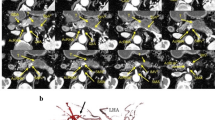Abstract
An aberrant left hepatic artery, arising from the left gastric artery (LHLG), either as an accessory or replacing the left hepatic artery, is occasionally seen in patients with gastric cancer. Resection of LHLG, as part of the gastrectomy procedure, may cause liver dysfunction. The surgical records of a group of 141 patients who had undergone gastrectomy for gastric cancer following preoperative angiography were reviewed. Twenty-eight of the patients had an LHLG preoperatively; in 15 the artery was severed during surgery and in the remainder it was preserved. Postoperative liver function was assessed by measuring changes in lactate dehydrogenase, glutamic oxaloacetic transaminase, and glutamic pyruvic transaminase activities. The greatest changes in liver function were observed in patients in whom the LHLG had been severed; the changes in liver function among patients whose LHLGs were preserved were similar to those in patients who had no LHLG. Notably, the wider the area fed by the LHLG, the greater was the change in liver function. The observed liver dysfunctions were transient, however, and normal function resumed within 7 days after operation.
Résumé
Lors de la chirurgie gastrique pour cancer, il arrive que l'artère hépatique gauche, lorsqu'elle prend naissance de l'artère coronaire stomachique (AHG/CS), soit dévascularisée lors de la ligature de l'artère coronaire stomachique ou qu'elle soit sectionnée lors de la dissection. La dévascularisation peut parfois Être à l'origine de troubles hépatiques postopératoires. Chez 141 patients ayant eu une étude artériographique avant d'avoir une gastrectomie pour cancer, 28 patients avaient une AHG/ CS. Parmi ceux-ci, l'AHG/CS a été sectionnée dans 15 cas. La fonction hépatique postopératoire a été évaluée par les dosages de la lactate déshydrogénase, des transaminases glumatopyruviques et glutamo-oxalo-acétiques. Les modifications les plus importantes ont été enrégistrées chez les patients qui avaient eu une ligature de leur AHG/CS, alors que ces mÊmes fonctions hépatiques n'étaient pas perturbées chez les patients ayant une AHG/CS non sectionnée ou n'ayant pas une AHG/CS. En plus, on a remarqué que les perturbations de la fonction hépatique étaient proportionnelles au territoire irrigué par l'AHG/CS. Ces perturbations, cependant, étaient habituellement transitoires et, le plus souvent, ces patients ont récupéré une fonction hépatique normale en moins de 7 jours.
Resumen
La lesión o división de la arteria hepática izquierda que se origina en la arteria gástrica izquierda (AHAG) ocurre ocasionalmente durante una operación por cáncer gástrico, lo cual puede causar disfunción hepática postoperatoria. Se revisaron 141 pacientes sometidos a gastrectomía por cáncer gástrico después de angiografía preoparatoria. De los 28 pacientes con AHAG, en 15 se dividió la AHAG y no en los restantes. La función hepática postoperatoria estimada mediante la determinación de los cambios en los niveles de deshidrogenasa láctica (LDH), transaminasa glutámica oxaloacética y transaminasa glutámico pirÚvica (GPT). La mayor alteración en la función hepática fue observada en los pacientes en quienes se dividió la AHAG, en tanto que los cambios en la función hepática con preservación de la AHAG fueron similares a los observados en los pacientes sin AHAG. Fue notorio que entre mayor el área irrigada por la AHAG, mayor el grado de alteración en la función hepática. La disfunción hepática tuvo carácter transitorio, y la función hepática se normalizó en los primeros siete días postoperatorios.
Similar content being viewed by others
References
Vandamme, J.P.J., Bonte, J., van der Schueren, G.: A re-evaluation of hepatic and cystic arteries: the importance of the aberrant hepatic branches. Acta Anat. (Basel)73:192, 1969
Michel, N.A.: Newer anatomy of liver—variant blood supply and collateral circulation. J.A.M.A.172:125, 1960
Naidich, J.B., Naidich, T.P., Sprayregen, S., Hyman, R.A., Pudlowski, R.M., Stein, H.L.: The origin of the left gastric artery. Radiology126:623, 1978
Plengvaint, U., Chearanai, O., Sindvananda, K., Damrongsak, S., Viranuvatti, V.: Collateral arterial blood supply of the liver after hepatic artery ligation: angiographic study of twenty patients. Ann. Surg.175:105, 1972
Koehler, A.C., Korobkin, M., Lewis, F.: Arteriographic demonstration of collateral arterial supply of the liver after hepatic artery ligation. Radiology117:49, 1975
Lurie, A.S.: The significance of the variant left accessory hepatic artery in surgery for proximal gastric cancer. Arch. Surg.122:725, 1987
Author information
Authors and Affiliations
Rights and permissions
About this article
Cite this article
Okano, S., Sawai, K., Taniguchi, H. et al. Aberrant left hepatic artery arising from the left gastric artery and liver function after radical gastrectomy for gastric cancer. World J. Surg. 17, 70–73 (1993). https://doi.org/10.1007/BF01655708
Issue Date:
DOI: https://doi.org/10.1007/BF01655708




